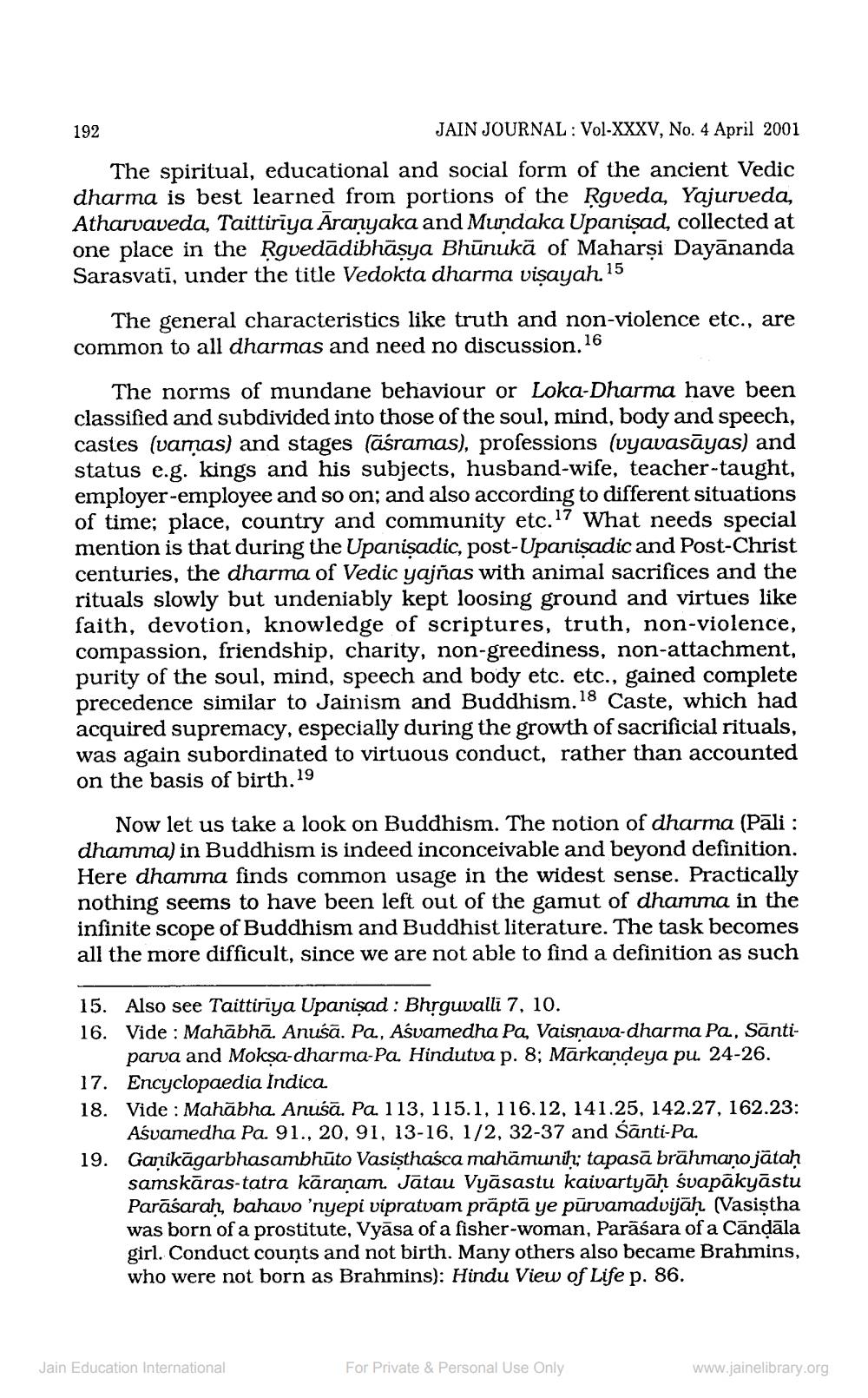________________
JAIN JOURNAL: Vol-XXXV, No. 4 April 2001
The spiritual, educational and social form of the ancient Vedic dharma is best learned from portions of the Ṛgveda, Yajurveda, Atharvaveda, Taittiriya Aranyaka and Mundaka Upanisad, collected at one place in the Ṛgvedadibhāṣya Bhūnukā of Maharṣi Dayānanda Sarasvati, under the title Vedokta dharma viṣayah. 15
192
The general characteristics like truth and non-violence etc., are common to all dharmas and need no discussion. 16
The norms of mundane behaviour or Loka-Dharma have been classified and subdivided into those of the soul, mind, body and speech, castes (vamas) and stages (asramas), professions (vyavasāyas) and status e.g. kings and his subjects, husband-wife, teacher-taught, employer-employee and so on; and also according to different situations of time; place, country and community etc. 17 What needs special mention is that during the Upanisadic, post-Upanisadic and Post-Christ centuries, the dharma of Vedic yajñas with animal sacrifices and the rituals slowly but undeniably kept loosing ground and virtues like faith, devotion, knowledge of scriptures, truth, non-violence, compassion, friendship, charity, non-greediness, non-attachment, purity of the soul, mind, speech and body etc. etc., gained complete precedence similar to Jainism and Buddhism. 18 Caste, which had acquired supremacy, especially during the growth of sacrificial rituals, was again subordinated to virtuous conduct, rather than accounted on the basis of birth.
19
Now let us take a look on Buddhism. The notion of dharma (Pāli : dhamma) in Buddhism is indeed inconceivable and beyond definition. Here dhamma finds common usage in the widest sense. Practically nothing seems to have been left out of the gamut of dhamma in the infinite scope of Buddhism and Buddhist literature. The task becomes all the more difficult, since we are not able to find a definition as such
15. Also see Taittiriya Upanisad: Bhrguvalli 7, 10.
16. Vide: Mahābhā. Anusā. Pa., Asvamedha Pa, Vaisnava-dharma Pa, Santiparva and Mokṣa-dharma-Pa. Hindutva p. 8; Markandeya pu. 24-26. 17. Encyclopaedia Indica
18. Vide Mahabha. Anusā. Pa. 113, 115.1, 116. 12, 141.25, 142.27, 162.23: Asvamedha Pa. 91., 20, 91, 13-16, 1/2, 32-37 and Santi-Pa.
19. Gaṇikāgarbhasambhūto Vasisthasca mahāmuniḥ; tapasā brāhmaṇo jātaḥ samskāras-tatra kāraṇam. Jātau Vyāsastu kaivartyāḥ śvapākyāstu Parasaraḥ, bahavo 'nyepi vipratvam präptā ye pūrvamadvijāḥ (Vasistha was born of a prostitute, Vyasa of a fisher-woman, Parāśara of a Canḍāla girl. Conduct counts and not birth. Many others also became Brahmins, who were not born as Brahmins): Hindu View of Life p. 86.
Jain Education International
For Private & Personal Use Only
www.jainelibrary.org




